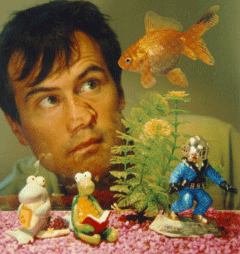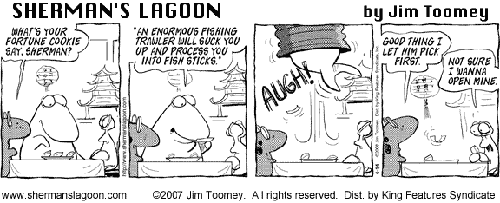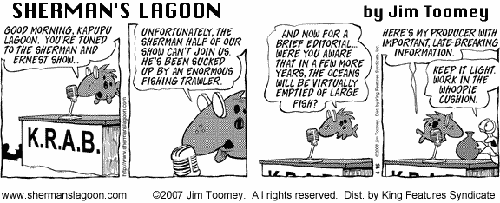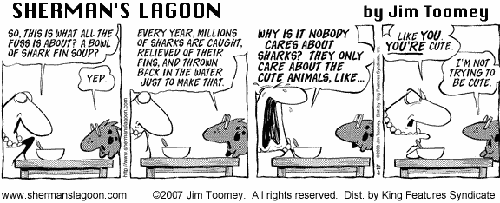Cartoon with a Message
Air Date: Week of March 13, 2009

Jim Toomey is an artist and author of the nationally syndicated comic strip Sherman's Lagoon
Artists sometimes use their medium to send a message. Cartoonist Jim Toomey’s are in a bottle. His syndicated comic strip “Sherman’s Lagoon” has a cast of aquatic characters who live in the South Pacific and ponder environmental issues about the ocean. Toomey tells host Bruce Gellerman about how he uses humor to educate his readers.
Transcript
GELLERMAN: The state of the world’s oceans is serious stuff - fish are becoming scarce - coral is dying - and the seas are filled with plastic flotsam.
No, nothing to laugh at - unless you catch the syndicated newspaper comic, Sherman’s Lagoon. The comic strip features a cast of coral reef critters living on Kapupu Lagoon in the South Pacific.
The creator is cartoonist Jim Toomey. Jim was among those at the recent Blue Vision Summit in Washington, DC, a gathering of 150 organizations that deal with ocean issues - and Jim Toomey joins me from the nation’s capital.
Hi Jim, welcome to Living on Earth.
TOOMEY: Thanks, happy to be here Bruce.
GELLERMAN: So what’s a cartoonist doing at the Blue Vision Summit about the ocean?
TOOMEY: [Laughs] Well, first of all, cartoonists have more time than they know what to do with, so we get involved in all kinds of crazy things. The Blue Vision Summit was a natural connection to my interests in my comic strip, because my comic strip is set under water, and it’s got a lot of the same characters that we’re trying to save at the Blue Vision Summit. The Blue Vision Summit’s all about bringing together a wide variety of non-profits and government folks and academics and cartoonists and artists to discuss ocean conservation.
GELLERMAN: Well, let’s talk about your creation here a little bit and how it fits into the ocean.
TOOMEY: Sure.

Sherman's Lagoon is meant to be entertaining but Jim Toomey does sometimes address serious issues
GELLERMAN: There’s Sherman, your dim-witted shark. He eats gum off the seats of movie theaters.
TOOMEY: Yeah, well, he’s kinda of a scavenger. He’s – I made him my main character because he’s naïve and he’ll pretty much say anything, which is great for a main character, even though he’s not the brightest light bulb in the box.
GELLERMAN: [Laughter] His side kick, though, Fillmore, the sea turtle …
TOOMEY: Fillmore’s a sea turtle, and he’s sort of the rational half of the two. He’s the Hardy of the Laurel and Hardy, if you will. And Sherman will say anything and do anything, and Fillmore kinda keeps him in check. I try to round out the cast with a couple of other characters like Hawthorn the irascible hermit crab. He’s always thinking up a new business plan and trying to swindle people out of their hard earned money. And there’s Sherman’s wife Megan who’s kind of an overbearing, but sensitive female shark. And then there’s Earnest who is kind of a nerd, a little fish who surfs the internet and poses as a human on the internet, and he causes all kinds of problems on the dirt side of the world.

Jim Toomey is an artist and author of the nationally syndicated comic strip Sherman's Lagoon
GELLERMAN: The character who interests me is Thorton, the polar bear …
TOOMEY: [Laughter]
GELLERMAN: .. who basically hitches an iceberg and winds up in the South Pacific lagoon.
TOOMEY: He’s a lot of people’s favorite character. And a lot of these characters are just little parts of my own character. And as a cartoonist I get a lot of grief for having a lot of spare time and doing fun things like this Blue Vision Summit. And Thorton’s always on vacation, he’s always just laying on the beach. And polar bears don’t really hibernate, but this one he hibernates on the beach, this fictional beach were my lagoon is set, pretty much all summer and then – or all winter, I’m sorry – and then he goes off to various places to live his real life. And couple of times I’ve taken him back to the north pole where I’ve done some cartoons on the polar ice melting up there.
GELLERMAN: Yeah, I was going to ask you – you’ve got a degree in environmental management. How would Thorton and the rest of your crew, you know, fare with global warming and the rising sea level and the acidification of the ocean?

(Courtesy of Jim Toomey)
TOOMEY: Right well, they’re not faring well in the real world and what I’m trying to do without trying to beat my readers over the head with an environmental stick is to make them aware of that. So when I did bring Thorton the Polar Bear up back to his home, I had him swimming around, I had him looking for ice and floating around on a very small iceberg and so forth. So, in that kind of subtle way, I’m making readers aware that there are large problems out there.
GELLERMAN: So is the art of making a comic subversive …
TOOMEY: [Laughter]
GELLERMAN: … that is you know, kind of slipping in that environmental message.
TOOMEY: Well, subversive is kind of a strong word, but maybe subtle. I’m cartoonist first and an environmentalist second. My job, if you want to call it a job, is to entertain, and if I stop entertaining then I lose my readership, and if I lose my readership, then I – it doesn’t matter what my message is, nobody’s gonna read it. So my priority is to make readers come to the paper and read the strip, and then I can slip an environmental message in there. Part of the mission of the cartoon is to make people aware that there’s a lot more complexity under that surface. And sometimes that doesn’t come through in the nature documentaries and the books and so forth. The actual animal behavior that I like to weave into the comic strip. For instance, Fillmore the Sea Turtle, he’s a green sea turtle, and he goes to this place called Ascension Island where real green sea turtles go to lay eggs. So I weave those real marine biology nuggets into the comic strip and by the end of reading a series hopefully you’ve picked up a thing or two about the environment and about the science of the ocean.
GELLERMAN: Where do you get your ideas from? Do you read the science journals or just the news about environmental issues in the ocean and try to incorporate them into the cartoon?

(Courtesy of Jim Toomey)
TOOMEY: Sure, I do a lot of that. And part of the reason I got the masters degree in environmental management was to build a better foundation to understand some of those articles at a deeper level than your average person. So I try to distill it down to some simple messages because you can’t really get too complicated, especially with a comic strip, you have to distill it down to a very simple message.
GELLERMAN: So you can have a serious message in this comic.
TOOMEY: Well, yeah, maybe not a message, but a serious fact or two. In the end I hope to make people laugh, but in a way that provokes their thought. I ran a Sunday comic strip a while back that spoke to sustainable seafood where there was Sherman the Shark and then there was Hawthorn the Hermit Crab. And Hawthorn was pointing out the different fish swimming by and how some fish are okay to eat in a seafood restaurant and some aren’t and you can eat this snapper …
GELLERMAN: [Laughter]
TOOMEY: … and you can’t eat this salmon and so forth and so forth. And by the second to last panel, a human snorkler went by and Hawthorn says to Sherman “you can eat as many of those as you want.”
GELLERMAN: [Laughter] I knew where you were going. [Laughter] I saw the panel.
I want to ask you about your musical, Sherman’s Lagoon is…
TOOMEY: Yeah, sure.
GELLERMAN: … now in the theater.
TOOMEY: It premiered last year. And it’s – knock wood – destined for a regional theater or two. And it’s fantastic. I can say that because I didn’t have a lot to do with the music part of it, and the music just knocked my socks off.
GELLERMAN: Well Jim Toomey, I really enjoyed talking with you.
TOOMEY: It was a pleasure to be here Bruce.
GELLERMAN: Cartoonist Jim Toomey is the creator of the newspaper comic strip, Sherman’s Lagoon.
Links
Living on Earth wants to hear from you!
Living on Earth
62 Calef Highway, Suite 212
Lee, NH 03861
Telephone: 617-287-4121
E-mail: comments@loe.org
Newsletter [Click here]
Donate to Living on Earth!
Living on Earth is an independent media program and relies entirely on contributions from listeners and institutions supporting public service. Please donate now to preserve an independent environmental voice.
NewsletterLiving on Earth offers a weekly delivery of the show's rundown to your mailbox. Sign up for our newsletter today!
 Sailors For The Sea: Be the change you want to sea.
Sailors For The Sea: Be the change you want to sea.
 The Grantham Foundation for the Protection of the Environment: Committed to protecting and improving the health of the global environment.
The Grantham Foundation for the Protection of the Environment: Committed to protecting and improving the health of the global environment.
 Contribute to Living on Earth and receive, as our gift to you, an archival print of one of Mark Seth Lender's extraordinary wildlife photographs. Follow the link to see Mark's current collection of photographs.
Contribute to Living on Earth and receive, as our gift to you, an archival print of one of Mark Seth Lender's extraordinary wildlife photographs. Follow the link to see Mark's current collection of photographs.
 Buy a signed copy of Mark Seth Lender's book Smeagull the Seagull & support Living on Earth
Buy a signed copy of Mark Seth Lender's book Smeagull the Seagull & support Living on Earth

